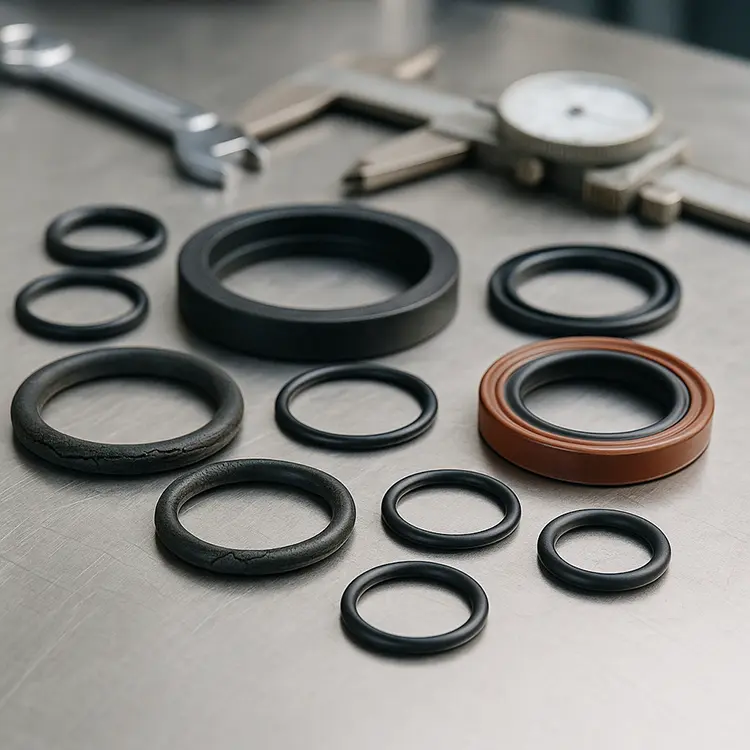Introduction
Seal integrity is critical in industrial and automotive systems because it ensures the safe, efficient, and economical operation of equipment. Leaks, whether air or liquid, can result in significant downtime, pose safety risks, contribute to environmental harm, and lead to substantial financial losses. In this comprehensive guide, I will cover the 9 most common leakage issues encountered with seals and provide actionable solutions to address them effectively.
1. Understanding Seal Leakage: Why It Happens
Seals perform essential roles in static and dynamic applications, preventing the unwanted flow of liquids or gases. However, improper design, unsuitable material selection, and inadequate maintenance practices can compromise seal integrity. External factors such as extreme temperatures, exposure to chemicals, high pressure, and vibration further exacerbate these issues, leading to premature seal failures.
2. The 9 Most Common Seal Leakage Problems and Solutions
2.1 Compression Set and Loss of Elasticity
- Problem: Seals permanently deform and lose elasticity, compromising their sealing capabilities.
- Causes:
- Extended exposure to high temperatures
- Excessive tightening during installation
- Poor material resilience
- Solutions:
- Opt for resilient materials like FKM and Silicone
- Adhere to proper torque guidelines
- Regular preventive maintenance and timely seal replacements
2.2 Chemical Degradation (Swelling, Cracking, or Softening)
- Problem: Chemical interactions damage seal integrity.
- Causes:
- Material incompatibility with process fluids
- Unanticipated additive reactions
- Solutions:
- Refer to chemical compatibility charts
- Choose materials suitable for specific fluids (EPDM for water, NBR for oils, PTFE for aggressive chemicals)
2.3 Extrusion and Nibbling
- Problem: Seal material extrudes into gaps under pressure, causing erosion.
- Causes:
- High system pressure
- Poor hardware tolerances
- Use of soft materials in high-pressure conditions
- Solutions:
- Incorporate anti-extrusion rings
- Ensure precise hardware tolerances and finishes
- Select harder seal materials
2.4 Improper Installation Damage
- Problem: Damage occurs during installation, reducing seal effectiveness.
- Causes:
- Lack of lubrication
- Sharp metal edges or burrs
- Incorrect tools or installation methods
- Solutions:
- Apply compatible lubricants
- Deburr and chamfer metal components
- Proper training and use of appropriate tools
2.5 Thermal Cycling (Expansion and Contraction)
- Problem: Temperature fluctuations cause shrinkage or cracking.
- Causes:
- Frequent startup and shutdown cycles
- Thermal expansion mismatch between seals and components
- Solutions:
- Choose thermally stable materials (e.g., Silicone, PTFE)
- Design seal glands to allow thermal movements
- Regular inspections and timely replacements
2.6 Aging and Environmental Attack (UV, Ozone, Weathering)
- Problem: Environmental exposure leads to seal deterioration.
- Causes:
- UV radiation
- Ozone degradation
- Weather conditions
- Solutions:
- Select UV and ozone-resistant materials (EPDM, FKM)
- Apply protective coatings or housings
- Scheduled maintenance and replacement
2.7 Incorrect Gland or Groove Design
- Problem: Poor housing design causes seal failures.
- Causes:
- Incorrect groove dimensions
- Excessive surface roughness
- Solutions:
- Follow manufacturer’s design guidelines
- Ensure recommended surface finish (Ra ≤ 0.8 µm for O-rings)
- Consult design engineers for validation
2.8 Vibration and Dynamic Movement
- Problem: Seal failures in vibrating or dynamic systems.
- Causes:
- Dynamic sealing environments (shafts, pistons)
- Machinery vibrations
- Solutions:
- Employ dynamic seal types (lip or mechanical seals)
- Select wear-resistant materials (FKM, PTFE)
- Implement vibration damping techniques
2.9 Surface Finish or Hardware Defects
- Problem: Surface irregularities cause leaks.
- Causes:
- Poor machining or hardware corrosion
- Hardware wear over time
- Solutions:
- Maintain proper surface finishes
- Inspect and repair hardware components regularly
- Replace damaged hardware promptly
3. Case Studies: Real-World Leakage Problems and Fixes
3.1 HVAC Systems: Air Leakage Due to Aging Seals
- Example: Flexible duct connectors experienced leaks from deteriorated silicone seals.
- Solution: Upgraded to reinforced silicone-coated fabric for enhanced durability.
3.2 Chemical Processing Equipment: Liquid Leakage from Chemical Attack
- Example: EPDM seals degraded in acid-handling equipment.
- Solution: Switched to PTFE-based seals for chemical resistance.
3.3 Automotive Engines: Dynamic Seal Wear from Vibration
- Example: High-RPM engines experienced shaft seal wear.
- Solution: Implemented FKM lip seals with vibration dampening.
4. Best Practices for Preventing Seal Failures
- Conduct thorough material selection based on application-specific factors (temperature, pressure, chemical exposure).
- Adopt long-term sealing designs.
- Follow precise installation procedures.
- Establish proactive maintenance routines.
5. Conclusion
Ensuring leak-free performance requires attention to seal design, material selection, installation, and maintenance. For optimal results, collaborate with experienced suppliers and engineers.
Contact us for custom, high-quality sealing solutions. Our extensive experience and commitment to precision engineering ensure strong, reliable sealing performance.

